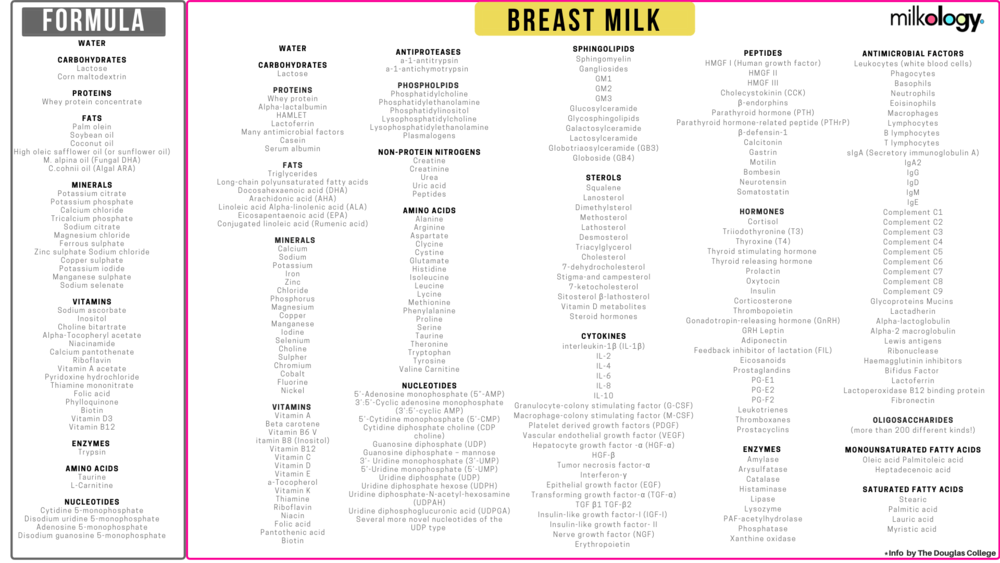
| NUTRIENT | BREAST MILK | FORMULA | COMMENT |
| FATS | Rich in brain-building omega 3’s, namely DHA and ARA. Automatically adjusts to infant’s needs; levels decline as baby gets older Rich in cholesterol Nearly completely absorbed. Contains fat-digesting enzyme, lipase. | No valid DHA. Doesn’t change with baby’s needs. No Cholesterol. Not completely absorbed. No lipase. | Fat is the most important nutrient in breast milk; In Formula: absence of cholesterol and DHA, vital nutrients for growing brains and bodies, may predispose child to adult heart and central nervous system diseases. Leftover unabsorbed fat accounts for unpleasant stools in formula-fed babies. |
| PROTEIN | Soft, easily-digestible whey. More completely absorbed Lactoferrin for intestinal health Lysozyme, an antimicrobial rich in brain and body-building protein components rich in growth factors. Contains sleep-inducing proteins. | Harder to digest casein curds. Less completely absorbed, more waste, harder on kidneys. None or trace lactoferrin. No lysozyme. Deficient or lower in some. Deficient in growth factors. | Automatically adjusts to infant’s needs. (i.e., higher in premature infant) |
| CARBS | Rich in lactose. oligosaccharides that promote intestinal health. | Some formulas contain no lactose. Deficient in oligosaccharides. | Lactose is considered an important carbohydrate for brain development. Studies show the level of lactose in the breast milk of a species correlates with the size of the brain of that species. |
| IMMUNE BOOSTERS | Rich in living white blood cells, millions per feeding. Rich in immunoglobulin. | No live white blood cells. Processing kills all cells. Dead food has less immunological benefit. Few immunoglobulin and mostly the wrong kind. | When mother is exposed to a germ, she makes antibodies to that germ and gives these antibodies to her infant via hermilk. |
| VITAMINS + MINERALS | Better absorbed, especially iron, zinc, and calcium. Iron is 50- 75% absorbed . Contains more selenium (an antioxidant) than formula. | Less absorbed iron, 5-10 percent absorbed. | Vitamins and minerals in breast milk enjoy a higher bio availability; a greater percentage is absorbed. To compensate, more is added to formula, which makes it harder to digest. |
| ENZYMES + HORMONES | Rich in digestive enzymes, such as lipase and amylase. Rich in many hormones: thyroid, prolactin, oxytocin, and over fifteen others. | Processing kills digestive enzymes. Processing kills hormones, which are not human, anyway. | Digestive enzymes promote intestinal health. Hormones contribute to the overall biochemical balance and well-being of baby. |
| TASTE | Varies with the mother’s breast milk. | Always taste the same. | By taking on the flavor of mother’s diet, breast milk shapes the tastes of the child to family foods. |
| COST | $600 a year, extra food for mother. | Around $1,500 per year for formula; up to $5,200 a year for hypoallergenic formulas. | Breast feeding families save $600 to $2,000 a year and often much more in medical bills since baby stays healthier. |
Educating yourself with evidence-based information is important, and without judgment is so important for your psychological and emotional well-being. It can be stressful if you feel alone in this, but you’re not.
Already just reading this shows what a great Mother you are! Go, Momma!
Here are some tips on formula feeding as well as tips on breastfeeding.
Learn more about how breastfeeding heals your breasts here.
Quiz: Do you know the 15 Breast Milk Nutrition Secrets?

